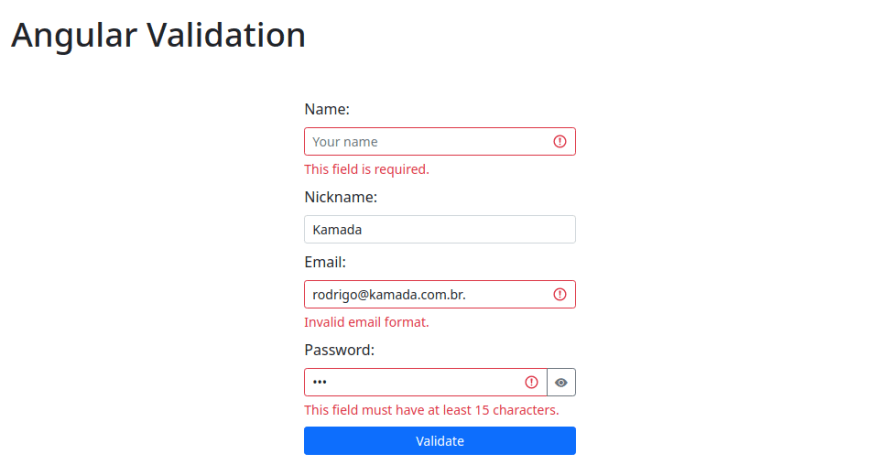An Interest In:
Web News this Week
- April 19, 2024
- April 18, 2024
- April 17, 2024
- April 16, 2024
- April 15, 2024
- April 14, 2024
- April 13, 2024
Adding form validation to an Angular application
Introduction
Angular is a development platform for building WEB, mobile and desktop applications using HTML, CSS and TypeScript (JavaScript). Currently, Angular is at version 13 and Google is the main maintainer of the project.
Form validation enables the quality, accuracy, and integrity of the user input data. Its possible to validate a form in Angular in two ways, one with reactive (using functions in the component class) and the other with template-driven forms (using attributes in the HTML) and we will use the template-driven forms way.
Prerequisites
Before you start, you need to install and configure the tools:
Getting started
Create the Angular application
1. Let's create the application with the Angular base structure using the @angular/cli with the route file and the SCSS style format.
ng new angular-validation --routing true --style scssCREATE angular-validation/README.md (1063 bytes)CREATE angular-validation/.editorconfig (274 bytes)CREATE angular-validation/.gitignore (620 bytes)CREATE angular-validation/angular.json (3279 bytes)CREATE angular-validation/package.json (1082 bytes)CREATE angular-validation/tsconfig.json (863 bytes)CREATE angular-validation/.browserslistrc (600 bytes)CREATE angular-validation/karma.conf.js (1435 bytes)CREATE angular-validation/tsconfig.app.json (287 bytes)CREATE angular-validation/tsconfig.spec.json (333 bytes)CREATE angular-validation/src/favicon.ico (948 bytes)CREATE angular-validation/src/index.html (303 bytes)CREATE angular-validation/src/main.ts (372 bytes)CREATE angular-validation/src/polyfills.ts (2338 bytes)CREATE angular-validation/src/styles.scss (80 bytes)CREATE angular-validation/src/test.ts (745 bytes)CREATE angular-validation/src/assets/.gitkeep (0 bytes)CREATE angular-validation/src/environments/environment.prod.ts (51 bytes)CREATE angular-validation/src/environments/environment.ts (658 bytes)CREATE angular-validation/src/app/app-routing.module.ts (245 bytes)CREATE angular-validation/src/app/app.module.ts (393 bytes)CREATE angular-validation/src/app/app.component.scss (0 bytes)CREATE angular-validation/src/app/app.component.html (23364 bytes)CREATE angular-validation/src/app/app.component.spec.ts (1109 bytes)CREATE angular-validation/src/app/app.component.ts (223 bytes) Packages installed successfully. Successfully initialized git.2. Install and configure the Bootstrap CSS framework. Do steps 2 and 3 of the post Adding the Bootstrap CSS framework to an Angular application.
3. Let's create a custom validator for the email field. Create the EmailValidatorDirective directive.
ng generate directive email-validator --skip-tests=trueCREATE src/app/email-validator.directive.ts (157 bytes)UPDATE src/app/app.module.ts (592 bytes)4. Change the src/app/email-validator.directive.ts file. Implement the Validator interface as below.
import { Directive } from '@angular/core';import { NG_VALIDATORS, AbstractControl, Validator, ValidationErrors } from '@angular/forms';@Directive({ selector: '[appEmailValidator]', providers: [{ provide: NG_VALIDATORS, useExisting: EmailValidatorDirective, multi: true, }],})export class EmailValidatorDirective implements Validator { private EMAIL_REGEXP = /^(([^<>()\[\]\.,;:\s@\"]+(\.[^<>()\[\]\.,;:\s@\"]+)*)|(\".+\"))@(([^<>()[\]\.,;:\s@\"]+\.)+[^<>()[\]\.,;:\s@\"]{2,})$/i; constructor() { } public validate(control: AbstractControl): ValidationErrors | null { const isValid = this.EMAIL_REGEXP.test(control.value); if (isValid) { return null; } else { return { emailValidator: { valid: false, }, }; } }}5. Change the src/app/app.component.ts file. Import the NgForm service, create the IUser interface and create the validate function as below.
import { Component } from '@angular/core';import { NgForm } from '@angular/forms';interface IUser { name: string; nickname: string; email: string; password: string; showPassword: boolean}@Component({ selector: 'app-root', templateUrl: './app.component.html', styleUrls: ['./app.component.scss'],})export class AppComponent { user: IUser; constructor() { this.user = {} as IUser; } public validate(form: NgForm): void { if (form.invalid) { for (const control of Object.keys(form.controls)) { form.controls[control].markAsTouched(); } return; } }}6. Change the src/app/app.component.html file. Add the form as below.
<div class="container-fluid py-3"> <h1>Angular Validation</h1> <div class="row justify-content-center my-5"> <div class="col-4"> <form #form="ngForm"> <div class="row"> <div class="col mb-2"> <label for="name" class="form-label">Name:</label> <input type="text" id="name" name="name" #name="ngModel" [(ngModel)]="user.name" placeholder="Your name" required minlength="1" maxlength="250" emailValidator class="form-control form-control-sm" [class.is-invalid]="name.invalid && (name.dirty || name.touched)"> <div *ngIf="name.invalid && (name.dirty || name.touched)" class="invalid-feedback"> <div *ngIf="name.errors?.['required']"> This field is required. </div> <div *ngIf="name.errors?.['minlength']"> This field must have at least 1 character. </div> <div *ngIf="name.errors?.['maxlength']"> This field must have at most 250 characters. </div> </div> </div> </div> <div class="row"> <div class="col mb-2"> <label for="nickname" class="form-label">Nickname:</label> <input type="text" id="nickname" name="nickname" #nickname="ngModel" [(ngModel)]="user.nickname" placeholder="Your nickname" maxlength="150" class="form-control form-control-sm" [class.is-invalid]="nickname.invalid && (nickname.dirty || nickname.touched)"> <div *ngIf="name.invalid && (name.dirty || name.touched)" class="invalid-feedback"> <div *ngIf="name.errors?.['maxlength']"> This field must have at most 150 characters. </div> </div> </div> </div> <div class="row"> <div class="col mb-2"> <label for="email" class="form-label">Email:</label> <input type="email" id="email" name="email" #email="ngModel" [(ngModel)]="user.email" placeholder="[email protected]" required minlength="1" maxlength="250" appEmailValidator class="form-control form-control-sm" [class.is-invalid]="email.invalid && (email.dirty || email.touched)"> <div *ngIf="email.invalid && (email.dirty || email.touched)" class="invalid-feedback"> <div *ngIf="email.errors?.['required']"> This field is required. </div> <div *ngIf="email.errors?.['minlength']"> This field must have at least 1 character. </div> <div *ngIf="email.errors?.['maxlength']"> This field must have at most 250 characters. </div> <div *ngIf="!email.errors?.['required'] && !email.errors?.['minlength'] && !email.errors?.['maxlength'] && email.errors?.['emailValidator']"> Invalid email format. </div> </div> </div> </div> <div class="row"> <div class="col mb-2"> <label for="password" class="form-label">Password:</label> <div class="input-group input-group-sm has-validation"> <input [type]="user.showPassword ? 'text' : 'password'" id="password" name="password" #password="ngModel" [(ngModel)]="user.password" required minlength="15" class="form-control form-control-sm" [class.is-invalid]="password.invalid && (password.dirty || password.touched)"> <button type="button" class="btn btn-outline-secondary" (click)="user.showPassword = !user.showPassword"> <i class="bi" [ngClass]="{'bi-eye-fill': !user.showPassword, 'bi-eye-slash-fill': user.showPassword}"></i> </button> <div *ngIf="password.invalid && (password.dirty || password.touched)" class="invalid-feedback"> <div *ngIf="password.errors?.['required']"> This field is required. </div> <div *ngIf="password.errors?.['minlength']"> This field must have at least 15 characters. </div> </div> </div> </div> </div> <div class="row"> <div class="col mb-2 d-grid"> <button type="button" class="btn btn-sm btn-primary" (click)="validate(form)">Validate</button> </div> </div> </form> </div> </div></div>7. Change the src/app/app.module.ts file. Import the FormsModule module and the EmailValidatorDirective directive as below.
import { FormsModule } from '@angular/forms';import { EmailValidatorDirective } from './email-validator.directive';declarations: [ AppComponent, EmailValidatorDirective,],imports: [ BrowserModule, FormsModule, AppRoutingModule,],8. Run the application with the command below.
npm start> angular-validation@1.0.0 start> ng serve Browser application bundle generation complete.Initial Chunk Files | Names | Sizevendor.js | vendor | 2.38 MBstyles.css, styles.js | styles | 486.75 kBpolyfills.js | polyfills | 339.09 kBscripts.js | scripts | 76.33 kBmain.js | main | 29.11 kBruntime.js | runtime | 6.87 kB | Initial Total | 3.30 MBBuild at: 2021-11-22T16:32:20.056Z - Hash: 1789217f1a21bafa - Time: 3632ms** Angular Live Development Server is listening on localhost:4200, open your browser on http://localhost:4200/ ** Compiled successfully.9. Ready! Access the URL http://localhost:4200/ and check if the application is working. See the application working on GitHub Pages and Stackblitz.
The application repository is available at https://github.com/rodrigokamada/angular-validation.
This tutorial was posted on my blog in portuguese.
Original Link: https://dev.to/rodrigokamada/adding-form-validation-to-an-angular-application-387a
Dev To
 An online community for sharing and discovering great ideas, having debates, and making friends
An online community for sharing and discovering great ideas, having debates, and making friendsMore About this Source Visit Dev To


